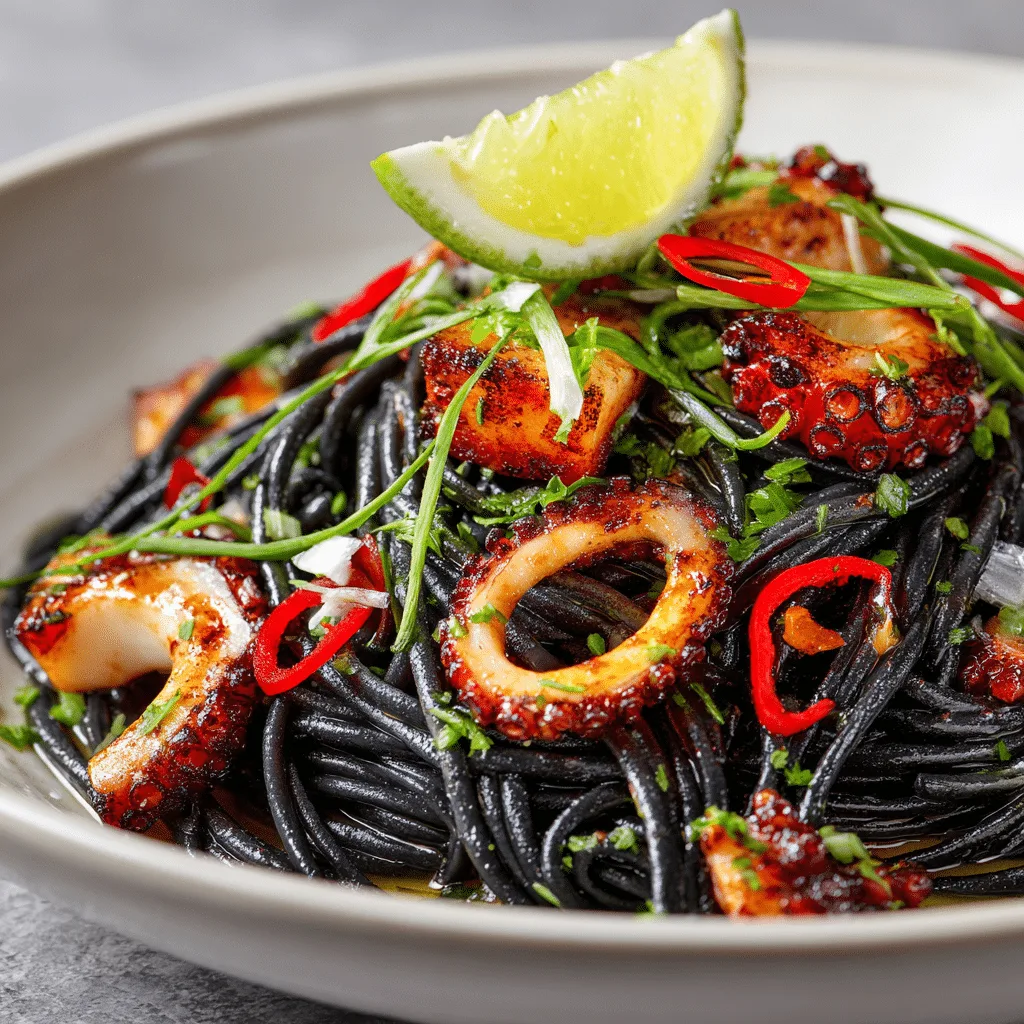Daring, delicious, and impossible to forget—this pasta squid ink recipe isn’t just a meal, it’s a conversation starter. With its bold black color and rich, ocean-kissed flavor, it transforms a simple dinner into something spectacular. But here’s the surprise: making it at home is easier than you’d ever imagine. Whether you’re hosting an elegant dinner party or treating yourself to something extraordinary, this recipe brings restaurant-level magic straight to your kitchen. Stick with me as we explore the story, the flavor, and every foolproof step of this striking dish. Get ready to fall in love with your new favorite pasta.
Table of Contents
Table of Contents
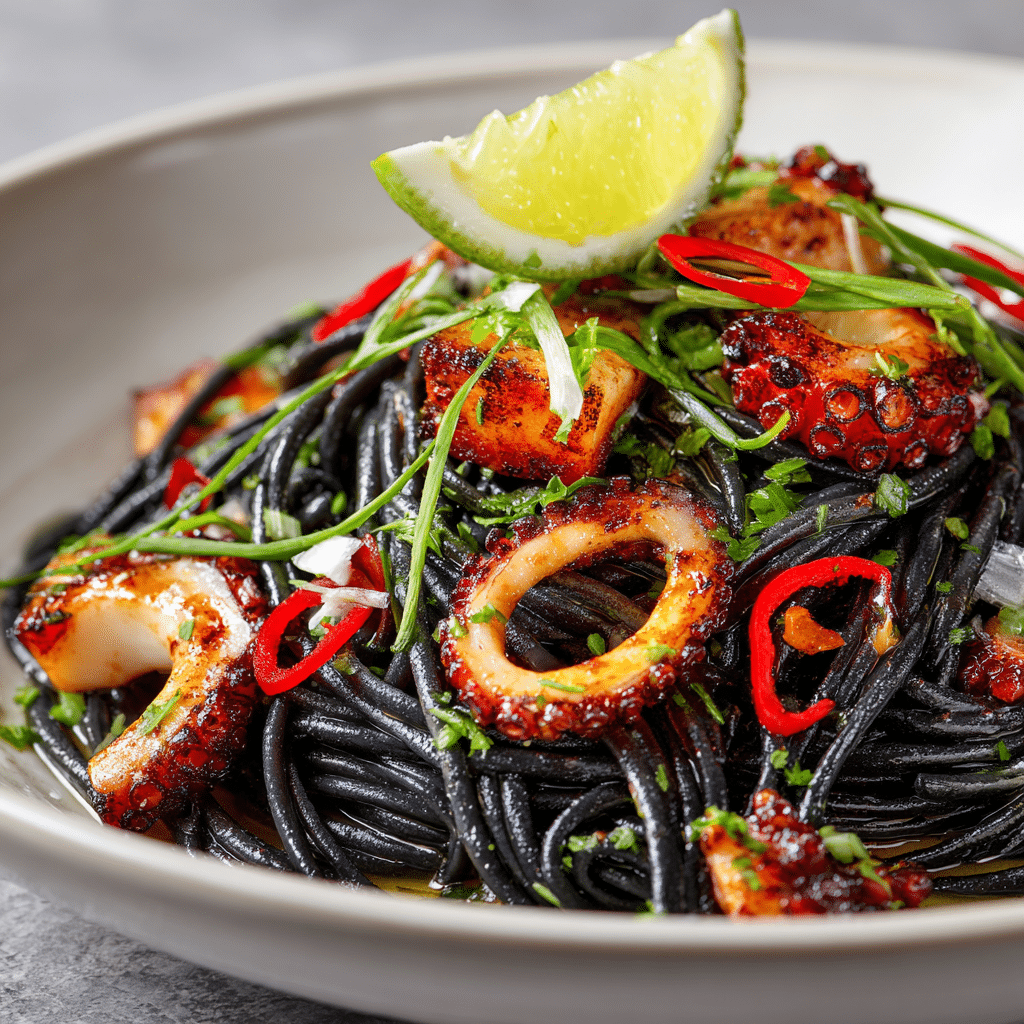
How One Bite of Squid Ink Pasta Changed My Cooking Forever
A Taste of the Sea That Stole My Heart
The first time I tried squid ink pasta, I was seated at a tiny trattoria on the Amalfi Coast during a much-needed getaway. I still remember the way the waves crashed nearby, the candlelight flickering on the table, and the server placing a jet-black plate of pasta before me. I hesitated, unsure what to expect—but one bite in, I was hooked. The flavor was briny, savory, and rich in a way no other pasta had ever been. That experience stuck with me, and when I got home, I knew I had to learn how to recreate it.
I’ll admit, I was a little intimidated at first. I’d never worked with squid ink, and the idea of dyeing pasta black seemed… ambitious. But I quickly learned that it’s far easier than it looks. In fact, once you master this pasta squid ink recipe, you’ll wonder why you ever waited to try it. It’s elegant, unique, and absolutely bursting with flavor.
Why This Pasta Squid Ink Recipe Works So Well
There’s something hypnotic about the contrast between the inky pasta and a vibrant garnish—like a dusting of chopped parsley or a golden sprinkle of Parmesan. But this recipe is more than just visual drama. The squid ink adds a distinct, slightly salty umami that pairs beautifully with seafood or even a touch of heat from crushed red pepper flakes.
It’s not just a meal; it’s a moment. A little adventurous, yes—but utterly worth it. Whether you’re crafting a romantic dinner or celebrating your love for coastal flavors, this is one recipe that makes a statement.
Craving something cozy for later in the week? Try this cabbage and carrots recipe or warm up with a classic corned beef in crock pot recipe.
Print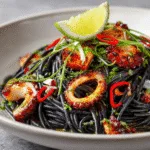
Pasta Squid Ink Recipe: A Bold, Beautiful Dish with Deep Flavor
- Total Time: 25 mins
- Yield: 2 servings 1x
Description
This pasta squid ink recipe brings bold color and rich, briny flavor to your table in under 30 minutes. Elegant, unforgettable, and surprisingly easy.
Ingredients
- 8 oz squid ink pasta
- 2 tsp squid ink (nero di seppia)
- 2 tbsp olive oil
- 3 cloves garlic, minced
- 1 small shallot, finely chopped
- 1/4 cup dry white wine
- 1/2 cup seafood stock (or pasta water)
- 1/4 tsp red pepper flakes
- Salt to taste
- Zest of 1 lemon
- 2 tbsp chopped parsley
- Optional: grated Parmesan or sautéed shrimp
Instructions
- Bring a large pot of salted water to a boil. Cook squid ink pasta until al dente. Reserve 1/2 cup pasta water.
- In a skillet, heat olive oil over medium heat. Add garlic and shallots; sauté until fragrant and soft, about 2 minutes.
- Deglaze with white wine. Let it reduce by half, then stir in squid ink and seafood stock. Simmer for 2–3 minutes.
- Add cooked pasta to the skillet and toss to coat. Use reserved pasta water as needed to loosen the sauce.
- Stir in lemon zest, red pepper flakes, and chopped parsley. Season with salt to taste.
- Plate and garnish with extra parsley, Parmesan, or shrimp if desired. Serve immediately.
Notes
Use high-quality squid ink pasta or make your own if you’re feeling adventurous.
Keep heat low to preserve the subtle flavor of the squid ink.
Best served immediately, but can be stored in an airtight container for 2 days.
- Prep Time: 10 mins
- Cook Time: 15 mins
- Category: Dinner
- Method: Stovetop
- Cuisine: Italian
Nutrition
- Serving Size: 1 bowl
- Calories: 420
- Sugar: 2g
- Sodium: 480mg
- Fat: 14g
- Saturated Fat: 3g
- Unsaturated Fat: 9g
- Trans Fat: 0g
- Carbohydrates: 56g
- Fiber: 3g
- Protein: 12g
- Cholesterol: 25mg
Choosing Ingredients for the Best Pasta Squid Ink Recipe
Start with Quality Ingredients for Maximum Flavor
A dish like this begins with the basics—each ingredient matters, and freshness is key. To make the best pasta squid ink recipe, start with high-quality dried or fresh squid ink pasta. You can often find it at Italian specialty stores, or even online. If you’re feeling adventurous, you can also make your own pasta and add squid ink to the dough for an extra authentic touch.
For the squid ink itself, look for small glass jars or packets labeled “nero di seppia.” Just a spoonful adds a bold, briny flavor and that signature deep black color. You’ll also need garlic, shallots, olive oil, white wine, red pepper flakes, and seafood stock—each one builds layers of flavor. And don’t skip the garnish: fresh parsley, lemon zest, or even a light grating of Parmesan can elevate the whole experience.
Prep Smart and Keep It Simple
One of the beauties of this recipe is how quickly it comes together. Start by prepping all your ingredients—mince the garlic and shallots, zest the lemon, and measure out your squid ink. This will keep you from scrambling once the cooking begins.
When you’re ready to cook, sauté your aromatics until soft and fragrant, then stir in the squid ink and wine. Let it simmer and meld, then toss in the pasta and finish with a ladle of pasta water to create a silky, glossy sauce. Top with parsley and a little citrus and serve it immediately.
If you enjoy recipes with deep, bold flavor, don’t miss the richness of our slow cooker corned beef or the hearty charm of this pink salt diet recipe.
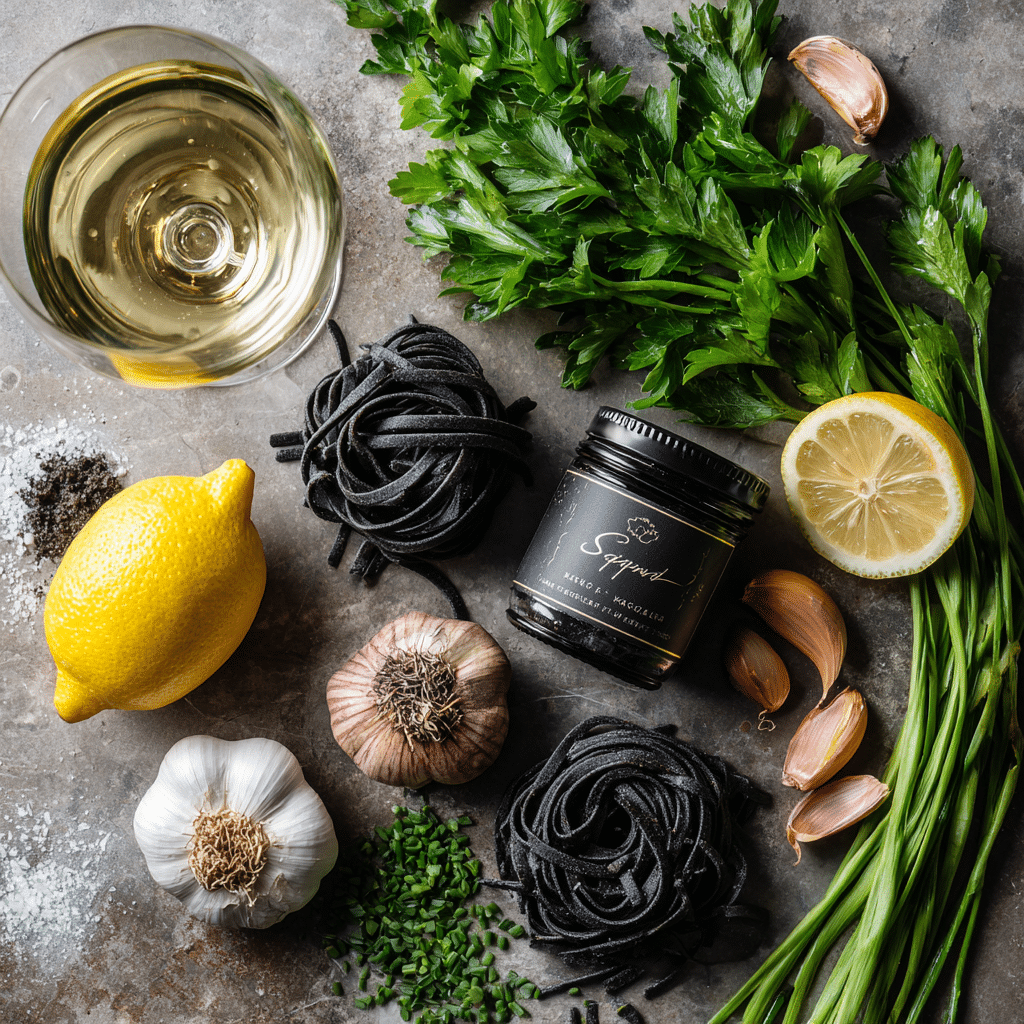
Cooking the Perfect Pasta Squid Ink Sauce
Build a Sauce That Elevates Every Bite
The sauce is where the real magic of this pasta squid ink recipe happens. Despite its deep, dark appearance, the flavor is anything but overpowering. It’s balanced, oceanic, and subtly complex. Begin by gently sautéing minced garlic and shallots in quality olive oil over medium heat. You want them soft and aromatic, not browned. This sets the stage for the squid ink to shine.
Next, add a splash of dry white wine. It brings acidity that cuts through the richness and deglazes the pan. Once the wine reduces, stir in your squid ink—just a tablespoon or two is enough. Watch as the sauce transforms into a glossy, inky base. Add seafood stock or reserved pasta water to loosen it up, allowing the starch to help bind everything together. The result? A luscious coating that clings beautifully to each strand of pasta.
Balance the Flavors with Finishing Touches
To round out the sauce, a pinch of crushed red pepper flakes brings warmth, while lemon zest or a squeeze of juice at the end brightens the entire dish. The sauce should taste briny but not fishy, bold but never overwhelming.
Once your pasta is al dente, transfer it directly into the pan with the sauce. Toss it all together until every strand is coated in that rich black sheen. Finish with a drizzle of olive oil and sprinkle fresh parsley for contrast.
If you’re loving bold flavors like this, try our cinnamon roll focaccia for a sweet and savory surprise, or explore the comforting richness of crock pot corned beef and potatoes.
Serving and Pairing Ideas for Squid Ink Pasta
Make a Statement with Stunning Presentation
When it comes to serving your pasta squid ink recipe, presentation is half the charm. The striking black pasta already provides a dramatic backdrop—now it’s about adding contrast and flair. A shallow white bowl or plate helps the dark noodles pop visually. For garnish, a handful of chopped flat-leaf parsley, a sprinkle of flaky sea salt, and a twist of lemon zest do wonders. If you want a touch of decadence, finish with a few shavings of Parmesan or pecorino.
For a fancier plating, try layering your seafood—like sautéed shrimp, scallops, or squid rings—right on top. It gives the dish texture, variety, and an elegant restaurant-style vibe. A drizzle of good olive oil or a dollop of lemon-infused crème fraîche can take things up a notch for special occasions.
Perfect Pairings for a Balanced Meal
This pasta is rich and briny, so you’ll want to pair it with sides and beverages that complement rather than compete. A crisp green salad with arugula, fennel, and citrus vinaigrette adds freshness and bite. For a heartier meal, try roasted vegetables or even a garlic-rubbed crostini to soak up any leftover sauce.
As for wine, dry whites are your friend. Think Pinot Grigio, Vermentino, or a light Albariño. Sparkling wines also add a festive, refreshing touch to this unique dish.
If this recipe is a bit of a showstopper, follow it up with a refreshing dessert like this fruity frozen yogurt bark or check out more crowd-pleasers in our easy meals section for weekday inspiration.
Common Mistakes to Avoid in a Squid Ink Pasta Recipe
Overpowering the Dish with Too Much Squid Ink
The number one mistake home cooks make with a pasta squid ink recipe is overdoing the ink. While it may be tempting to add more for that bold black color, too much can overwhelm the dish with an overly briny or metallic taste. Just one to two teaspoons per serving is plenty. Remember, squid ink is a flavor enhancer—not the main ingredient. Think of it like saffron or truffle oil: a little goes a long way.
Skipping Key Flavor Builders
It’s also common to skip or rush through the foundational ingredients—like garlic, shallots, or white wine. Don’t do it. These small steps add big depth to your sauce. Sauté your aromatics until soft, deglaze with wine, and let it reduce before adding the squid ink. These little layers of flavor are what make this dish shine.
Another overlooked tip? Salt your pasta water well—it’s your first chance to season the dish properly. And don’t forget to reserve some of that starchy pasta water for your sauce. It binds everything together and gives it that perfect silky finish.
Serving Without Texture or Contrast
A rich black pasta needs brightness and crunch. Skipping garnish is a missed opportunity to balance the dish visually and flavor-wise. Lemon zest, parsley, or even a few toasted breadcrumbs can completely transform the experience.
For more recipe tips and tricks, check out our cooking style section or explore flavor-forward dishes like this satisfying boursin pasta recipe.
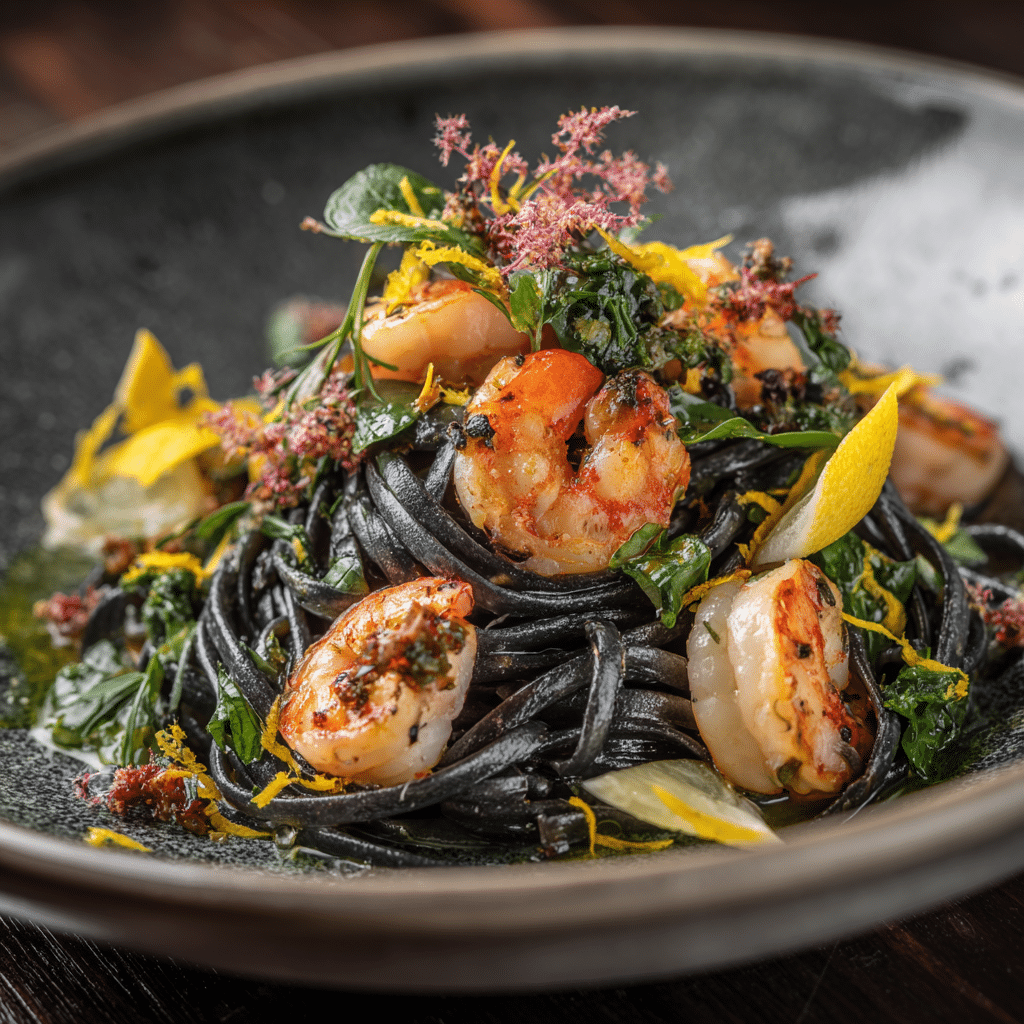
Variations on Squid Ink Pasta to Try
Seafood Lovers’ Dream: Add Shrimp, Scallops, or Mussels
One of the best things about a great pasta squid ink recipe is how customizable it is. Want to make it even more indulgent? Add fresh seafood like seared scallops, sautéed shrimp, or steamed mussels. The briny ink pairs beautifully with sweet, tender shellfish. To avoid overcooking, prepare the seafood separately and add it just before serving.
You can also try a seafood medley—think calamari rings, baby octopus, and even clams—for a bold feast that turns dinner into an experience. A splash of lemon juice and a little chili flake will bring balance to all that richness.
Vegetarian Twist: Earthy and Elegant
Don’t eat seafood? No problem. This dish works surprisingly well as a vegetarian main course, too. The umami from the squid ink is already powerful, so pairing it with earthy mushrooms (like cremini or shiitake), caramelized onions, and garlic gives it a grounded, savory profile.
Add roasted cherry tomatoes for a burst of sweetness or a swirl of mascarpone for creaminess. A spoonful of preserved lemon or sun-dried tomatoes also adds dimension. The result? A unique vegetarian pasta that feels anything but basic.
For other unique flavor pairings, don’t miss our pink salt diet recipe or dive into comforting ideas in the dessert section to find the perfect sweet finish.
This dish isn’t just a recipe—it’s a foundation you can build on. Once you master the basics, you’ll find endless ways to play with ingredients and make it your own.
Storing and Reheating Squid Ink Pasta
How to Store Leftovers Without Losing Flavor
Let’s be honest—this pasta squid ink recipe is so delicious, leftovers are rare. But if you do have some, storing it the right way is key to preserving its bold flavor and beautiful texture. First, let the pasta cool completely before transferring it to an airtight container. You can safely store it in the fridge for up to 2 days.
Because the sauce clings tightly to the pasta, it reheats better than cream- or oil-heavy dishes. However, make sure you store any seafood components—like shrimp or scallops—separately to avoid rubbery textures the next day.
Reheating Gently to Keep the Magic Alive
The trick to reheating squid ink pasta is low and slow. Add a splash of water or a drizzle of olive oil to a skillet and warm the pasta over medium-low heat. Stir gently to rehydrate the sauce and prevent sticking. Avoid the microwave if possible—it tends to dry out the noodles and alter the flavor.
If you saved any of the original seafood separately, warm it just until heated through and add it to the pasta right before serving. A quick garnish of fresh parsley or lemon zest can revive the brightness of the dish and make it feel like it was just made.
Want to explore more smart storage tips or low-effort weekday meals? Head over to our easy meals category or try something equally flavorful, like our fan-favorite corned beef in crock pot recipe.
Final Thoughts on Making the Best Pasta Squid Ink Recipe
Why You’ll Come Back to This Recipe Again and Again
At first glance, this pasta squid ink recipe might seem like something best left to upscale restaurants. But once you make it at home—once you taste that bold, briny sauce wrapped around perfectly cooked pasta—you’ll see how doable and delicious it truly is. It’s elegant, but not fussy. Impressive, but still approachable.
What makes it unforgettable isn’t just the flavor, but the experience of making something visually stunning and deeply satisfying. You’re not just putting a meal on the table—you’re serving a moment, a memory, a little taste of the sea.
Whether you keep it simple or dress it up with seafood or vegetarian twists, this recipe is one you’ll reach for again whenever you want to wow someone—or just treat yourself.
Make It Yours and Keep Exploring
The beauty of this dish is how flexible it can be. You can change up the protein, adjust the heat, or garnish it in a dozen ways to make it feel brand new. Once you’ve made it once, you’ll feel confident enough to play with it—and that’s when the real fun begins.
If you’re ready to keep your culinary momentum going, try baking something sweet like our cinnamon roll focaccia or learn how to enhance everyday flavor in your cooking through our cooking style section.
You don’t need a fancy kitchen or a trip to Italy to enjoy food that feels special. Just a few simple ingredients, a little heart, and the courage to try something new.
FAQ about pasta squid ink recipe
1. What does squid ink pasta taste like?
Squid ink pasta has a unique, savory flavor that’s slightly briny with rich umami depth. It doesn’t taste fishy—instead, it offers a subtle ocean essence that pairs beautifully with seafood, garlic, and citrus. The flavor is bold but well-balanced, especially when prepared with aromatics and wine as in this pasta squid ink recipe.
2. Can you make squid ink pasta without seafood?
Yes! While it’s traditionally paired with seafood, squid ink pasta works wonderfully in vegetarian dishes too. You can sauté mushrooms, shallots, and cherry tomatoes for an earthy twist, or finish it with creamy mascarpone and lemon zest for balance. This recipe is versatile and adapts easily to different dietary preferences.
3. Is squid ink safe to eat?
Absolutely. Squid ink is safe to eat and used widely in Mediterranean and Japanese cuisine. It’s typically sold in small packets or jars and contains no harmful ingredients. As long as it’s sourced from a reputable brand, it’s perfectly fine—and delicious—to include in your pasta squid ink recipe.
4. Where can I buy squid ink for cooking?
You can find squid ink at Italian grocery stores, seafood markets, or online specialty retailers. Look for labels like “nero di seppia” or “tinta de calamar.” A little goes a long way, so a small jar will last you through several batches of this stunning black pasta dish.

